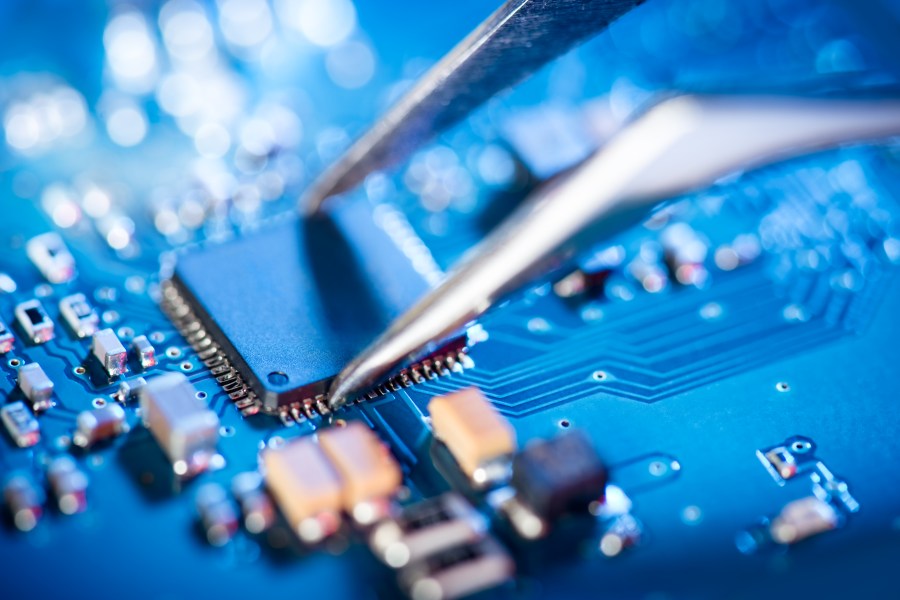The CHIPS Act could relieve some semiconductor chokepoints — but how quickly?

Semiconductor chips are part of the technology we use every day in electronics like electric toothbrushes, mobile phones and computers. And there are hundreds, if not thousands, of them in new vehicles.
But since the COVID-19 pandemic began, chips have been in short supply, causing, for example, some automakers to pause production lines. Some big tech firms predict the shortage will last into next year and perhaps beyond.
Marketplace’s Kimberly Adams spoke with Chris Miller, author of “Chip War: The Fight for the World’s Most Critical Technology,” out this week. He explained why this shortage happened. The following is an edited transcript of their conversation:

Chris Miller: It actually wasn’t a problem of supply — the number of chips we produce globally increased in 2020, and again in 2021 — but of demand, because the number of chips that we use surged as people wanted more access to smartphones, more working from home, more data centers. And just in general, we’re using more computing power across all aspects of the economy. And if you want more computing power, you need more chips.
Kimberly Adams: What has that meant for the relationships between the chip-producing countries and the chip-buying countries?
Miller: There’s more pressure than ever before to control and to compete for who produces chips, because although everyone relies on chips, a tiny number of companies and countries control their production. There’s, for example, one company in the Netherlands that produces all of the tools needed to make chips. Or Taiwan produces 90% of the most advanced processors, the type of chips that go in your iPhone or in your PC. So there are lots of chokepoints throughout the industry and the production process.
Adams: Your book digs into the history of this industry, going back to World War II. How did the United States get to this point of relying so much on other countries, particularly Taiwan, for this essential piece of technology?
Miller: The first chips emerged in the United States in Texas and in Silicon Valley — but over the last couple of decades, the manufacturing of chips has shifted offshore, above all to Taiwan, also to South Korea and China. In large part because it’s simply cheaper to manufacture chips there, because of tax incentives those countries provide, because of weaker environmental rules. There has been a surge in the offshoring of semiconductor production. But alongside that trend has been a number of U.S. companies that have fallen behind technologically, and Taiwan’s leading chip producer, [Taiwan Semiconductor Manufacturing Co.], has surged ahead, such that they can produce chips more advanced than anyone else in the world. And all of the chips we rely on, whether it’s smartphones, PCs, or data centers, in turn, many of them can only be produced in Taiwan.
Adams: Is that such a bad thing? I mean, Taiwan is an ally.
Miller: Well, Taiwan is an ally, but the Chinese military, which regularly threatens to assert control over Taiwan, is not. And one of the dangerous trends has been that even as the chip industry and the entire world economy has become more dependent on chipmaking in Taiwan, the Chinese military has been growing in strength such that today it’s far from clear that if China were to attack Taiwan, the U.S. would be able or willing to defend it.
Adams: Since you wrote your book, President Joe Biden signed the CHIPS and Science Act into law, which invests hundreds of billions of dollars in federal money into domestic chip production. How will that change these dynamics?
Miller: Thanks to the CHIPS Act, it’s going to become much less expensive to build semiconductor facilities in the United States. So this will begin to reduce the world’s reliance on Taiwan. But I think the reality is that for the foreseeable future, all of the world’s technology and thus the world economy will be hugely dependent on the steady access of chips in Taiwan.
Adams: What do you think all of this investment, and really, this sort of more public attention to the importance of chips and semiconductor technology, will mean for that global digital divide you talk about in your book?
Miller: Well, I think the more investment there is in semiconductor production, and especially in semiconductor R&D, will actually help to overcome some of the digital divide. Fifty years ago, most of the world, if they wanted to compute, had to lift their fingers up and down. And that was the only method of computation they had. And now, most of the world has access to a smartphone and all of the capabilities that it offers. That’s only possible thanks to the tremendous advances in our ability to miniaturize computing power on semiconductors.
Adams: What new technology or new advancement in the semiconductor industry has you the most excited, or interested, or, I guess, fearful?

Miller: Traditionally, advances in semiconductors have been powered by shrinking the components on semiconductors, which is why today semiconductors will have 10 billion or more tiny electrical circuits carved into them, each one of which is smaller than the size of a coronavirus. But at some point, it will be impossible to shrink those circuits further. And at that point, we’re going to have to find new ways to squeeze more computing power out of each chip. And so the really cutting-edge research right now is how to increase the amount of computing power we can get from chips at a time when at some point in the future and probably not that far in the future we’re going to be unable to make smaller components because they’re going to be facing fundamental limits set by the law of physics. And so that’s where a lot of the investment from the CHIPS Act is going to go into — what do we do when it becomes impossible, simply impossible, to shrink circuits further? And as a result, we need new methods for improving chips performance.
The future of this podcast starts with you.
Every day, the “Marketplace Tech” team demystifies the digital economy with stories that explore more than just Big Tech. We’re committed to covering topics that matter to you and the world around us, diving deep into how technology intersects with climate change, inequity, and disinformation.
As part of a nonprofit newsroom, we’re counting on listeners like you to keep this public service paywall-free and available to all.
Support “Marketplace Tech” in any amount today and become a partner in our mission.


















